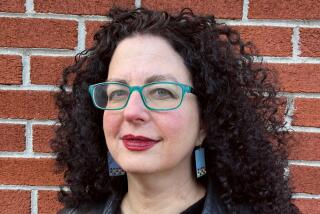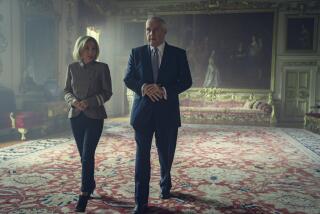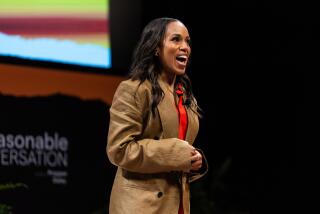âSATELLITE PRESS TOURSâ : THUMPING THE TUBS ELECTRONICALLY
George Merlis began as a newspaperman. He later worked for ABC News, first as a publicist, then as a field producer, then produced ABCâs âGood Morning America.â After that, he ran the âCBS Morning News,â then the syndicated âEntertainment Tonight.â
Now heâs back in publicity, the new-fashioned electronic kind. He co-owns J-Nex, a Los Angeles company that he and a partner, David Nemer, founded last September.
It produces or transmits âvideo press release materialâ via satellite, arranges satellite feeds of live or taped press conferences and sets up TV interviews conducted via satellite--âsatellite press tours,â as Merlis calls the latter.
He admits to mixed feelings about returning to the tub-thumping trade, even though he spent five years in it for ABC News and for six years worked for the networkâs entertainment division, which produces âGood Morning America.â
Before and after that, though, he worked in news, beginning as a sports editor in Italy for the Rome Daily American. He says his roots are in news.
âI try to toe the (journalistic) line and make what we do a service to both ends,â he says of his current calling. Itâs why, he adds, he recently turned down an offer to produce what is known in Hollywood as an âopen-ended interview.â
In these things, a kindly press agent, sitting off-screen, âinterviewsâ a star. As the videotape rolls, the star might be asked such piercing questions as: âDid you ever think your new comedy, âRaunchy,â would be such a smash hit?â
A few more such inquiries and the interview is completed and dispatched to TV stations--along with a script containing the PR manâs questions and the starâs replies to same. Any station desiring a âlocalâ presence in the interview, namely its own reporter or anchor, can excise the PR manâs portion of the tape.
The local party can be taped posing the questions provided in the script. This then is edited into the studioâs videotape package, making it appear that the stationâs own reporter did the interview.
In rejecting an offer to produce such a caper, Merlis says, âI said I thought it wasnât ethical.â
(The Federal Communications Commission has no hard-and-fast rule on whether such a practice is illegal, a spokesman says. But FCC policy requires a station to âexercise reasonable care and prudence with respect to its broadcast material in order to assure that no matter is broadcast which will deceive or mislead the public.â)
In talking with station news directors around the country, Merlis says, heâs found that the use of âopen-endedâ interviews by TV stations isnât anywhere as prevalent as it was in the late 1960s.
âI remember when I was first at ABC, I saw one of these coming down the line,â he adds. âI could not believe it.â
Now, he says, âfewer and fewerâ stations participate in such deceptions, partly because their standards have risen, partly because âthe audience is too sophisticated. They can smell it.â
The new trend, which he considers infinitely more honest, is the âsatellite press tourâ in which a star or other notable goes to a TV studio here or in New York to be interviewed via satellite by reporters sitting in their TV studios at stations across the country.
Not only does it mean a series of interviews can be conducted in one day, he says, itâs also far less costly and tiring than shipping the interviewee around the nation on a press tour.
In January, he helped organize such an electronic tour for Julie Andrews--his second such effort, he says, since helping arrange TV interviews in 16 markets for writer Frank Herbert to publicize the Universal movie made from Herbertâs novel, âDune.â
Unlike the âDuneâ session, the Andrews tour was done free, Merlis says. The actress was publicizing Operation California, a private relief organization of which she is an active board member. She had set aside a day to go to a small TV studio in Hollywood and discuss the organizationâs work via satellite.
Merlis donated his time and his companyâs TV contacts, Wold Communications of Los Angeles donated its satellite facilities and the Los Angeles office of an Australian TV company, Australia Channel Nine, provided a crew and the studio.
Produced and directed by Merlis, the four-hour session enabled TV reporters in seven American cities and in Australia to interview Andrews, one after another, about Operation California and its recent efforts to help starving people in Ethiopia.
Although each interview lasted only about 10 minutes, it was a prime example of how satellites have brought a new dimension to publicity.
Long-distance TV interviews, a visual version of the phone interviews that print reporters have done for decades, arenât new, at least for the major television networks. Edward R. Murrow helped pioneer them in the â50s, on his âPerson to Personâ series on CBS, using coaxial cables that since have gone the way of exclusive celebrity chats. What is new is that more local stations these days own their own satellite send-and-receive facilities, and now can do long-distance interviews themselves instead of relying on network or syndicated offerings.
This do-it-yourself trend can be a boon to entertainment publicists. But there are those who say the market for TV chats with stars is glutted.
Merlis disagrees. Viewers and reporters living in Los Angeles may consider the star interviews they constantly see on TV a sure cure for insomnia, he says, but âoutside Los Angeles, this stuff is not that readily available. And theyâ--viewers more than 100 miles from Hollywood and Vine--âgo for it. Theyâre curious.â
So it goes now for Merlis, a short, trim man of 45 who, because of disagreements with management and vice versa, left the syndicated âEntertainment Tonightâ last year after less than a year as its executive producer. Before that, his was a life of predawn wake-ups. From 1975 to 1981 he was executive producer of ABCâs âGood Morning America,â and until early 1983 the executive producer of the âCBS Morning News.â He never got around to trying his hand at NBCâs âTodayâ show, but says he never wanted to.
He grins when asked which of the three network morning shows he now watches most.
âI watch âCNN Headline News,â â he says. âI watch it because itâs all news and no personality. Thatâs what Iâm interested in. I want to find out if I should get out of bed, if I should sell stocks, and if itâs going to rain on me.â
More to Read
The biggest entertainment stories
Get our big stories about Hollywood, film, television, music, arts, culture and more right in your inbox as soon as they publish.
You may occasionally receive promotional content from the Los Angeles Times.










